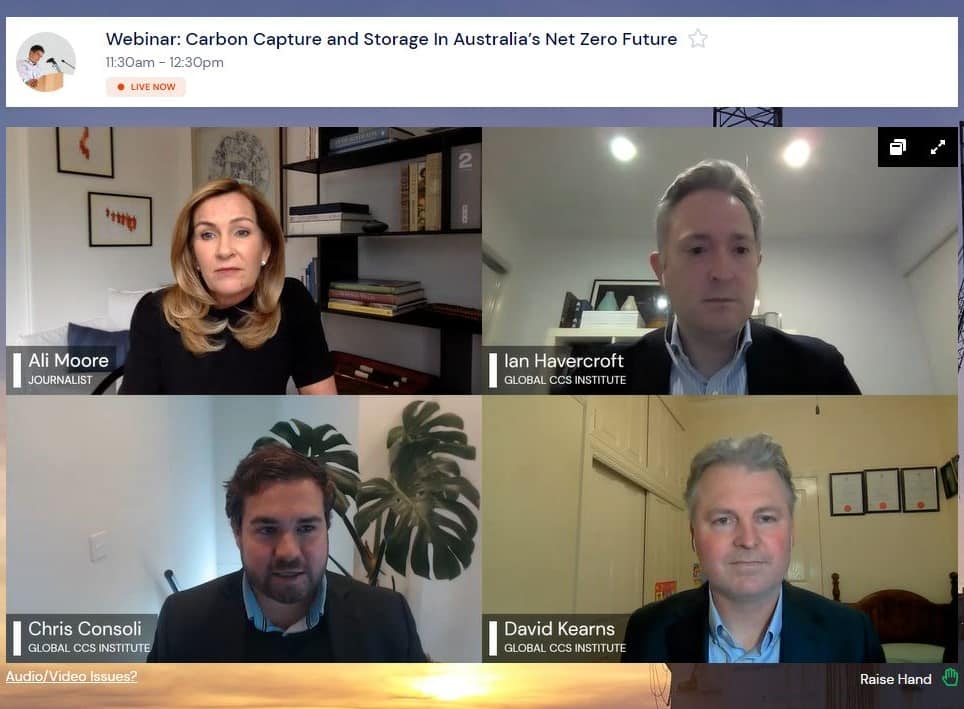17 Sep 2021
APPEA webinar casts spotlight on CCS opportunity
Our latest APPEA webinar cast a light on Australia’s opportunity for carbon capture and storage (CCS), a technology recognised by the Federal Government’s Technology Investment Roadmap as a way to help Australia on its emissions reduction journey.
Introduced by APPEA Deputy Chief Executive Damian Dwyer and hosted by renowned journalist Ali Moore, the webinar featured three guests from the international think tank, the Global CCS Institute, who delivered a fascinating insight into the exciting CCS industry.
Joining the webinar from the Institute were Chris Consoli, Senior Consultant – Storage; David Kearns, Principal Consultant – CCS Technology; and Ian Havercroft, Principal Consultant – Policy, Legal and Regulatory, and all three helped to bring their unique perspectives to the CCS landscape.
Mr Consoli kicked things off with a discussion of the global overview of CCS, including an explainer of how the technology works and a review of the past year’s deployments.
Mr Consoli that CCS involves the capture of CO2 from various industrial sources, including oil and gas projects, which is then compressed, transported, and safely stored via geological processes.
Mr Consoli also emphasised that CCS is a proven and mature technology that has been used all over the world since the early 70s. He also referred to the emissions reductions targets set out by the Intergovernmental Panel on Climate Change (IPCC), which requires between 348 gigatonnes (Gt) and 1,218Gt of CO2 to be stored this century, the equivalent of building 70-100 facilities per year globally to 2050.
“Almost all the scenarios under the IPCC’s 1.5-degree scenario target need carbon capture and storage,” he explained.
“[It is] a massive amount of CO2 to be captured, transported and stored but we know from precedents in other industries that it is achievable.
It is a massive undertaking, but a massive opportunity. We’re really talking about an energy revolution.”
Mr Kearns’ presentation emphasised that CCS is currently the lowest-cost option available to meet future emissions reduction targets in the oil and gas industry.
He referred to a study by the Institute of the typical range of capture cost methods, with natural gas processing included in the lowest cost bracket.
“Basically [it’s] because the industry has to separate CO2 as part of its regular business, so a lot of the hard work has already been done,” he said. “It provides an opportunity for low-cost capture.”
Mr Kearns added that the gas industry had a natural advantage when it came to scaling up the CCS industry since the natural gas processing industry can already produce CO2 at a significant scale, which can also help to reduce overall transport costs.

In addition, Mr Kearns touched on Australia’s blue hydrogen opportunity in the context of CCS. Blue hydrogen is a method of creating hydrogen from natural gas using steam methane reformation (SMR) in tandem with CCS to capture greenhouse gases emitted during the production process.
“At the moment, [CCS is] providing the opportunity for lowest-cost clean hydrogen production,” he said.
“SMR is the conventional way of producing hydrogen from natural gas, it’s been used in oil refining for a long time and is also a way that we can produce hydrogen in a decarbonised fashion by coupling it with CCS.
“Costs vary at the moment depending on the cost of the feedstock, but we’re seeing [an average of] $1.50-$2.50 USD per kilogram, considerably cheaper than electrolysis.”
Finally, Mr Havercroft took the (virtual) floor to discuss CCS from a policy perspective, citing recent Commonwealth and state-level regulatory framework developments (such as the recent expansion of the ARENA remit) that support the development of CCS projects in Australia.
Mr Havercroft then touched on CCS from an environmental, social and government (ESG) perspective, citing climate change as being of particular importance.
“Industry is facing increasing scrutiny of how it approaches the issue of climate change within its operations, with a greater level of shareholder scrutiny, wider communities and regulators,” Mr Havercroft said.
“For those organisations with significant CO2 exposure the materiality of their greenhouse gas emissions is increasingly being considered by investors and the wider public.”
Mr Havercroft also touched on social licence, referring to public perception of CCS technology as somewhat outdated, a factor that has impacted several early projects in Australia and overseas.
“CCS is viewed by many as solely a coal application, something reported regularly by the press and a number of interest groups,” he said.
“Linked to that is the notion that CCS will continue to prolong the life of fossil fuels, which is not a point the Institute takes or many in the CCS community take – we see it as a transition technology.”
Mr Havercroft also cited the Tomakomai project in Japan as a particularly effective example on how to engage people on the benefits of CCS from a climate and community perspective.
It was just one example, he said, of the substantial body of work developed from early experience and deep technical understanding that is now available to project proponents and policymakers.
“There’s a real challenge around mitigating the impacts of climate change globally – we need to implement policy and regulation in a timely manner,” Mr Havercroft said.
The full webinar is available to APPEA members and can be viewed via the APPEA Portal here.

